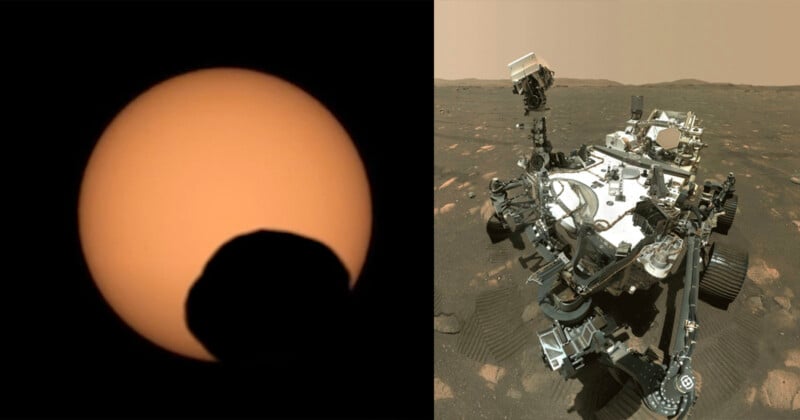
Trundling over the Martian surface, NASA’s Perseverance Rover looked upward at the Sun on September 30 to see a “googly eye” looking back at it.
Although it looked like an eye, what Perseverance was really seeing was an eclipse caused by the Martian moon Phobos crossing the Sun.
Phobos, the larger of Mars’ two moons, treated Perseverance to a show on the spacecraft’s 1,285th Martian day of its mission. It is too small to create a total eclipse so rather than blocking out our nearest star it makes a silhouette as it transits the solar surface.
NASA shared a video of the celestial event yesterday (October 30) which shows Phobos — a potato-shaped moon roughly 17 miles wide — transiting the solar disk. The shadow it cast on the surface of the Sun briefly made Phobos look like the pupil of an eye and the Sun the iris.
And while such a celestial event is amazing to us here on Earth, solar eclipses actually happen much more often on Mars because Phobos orbits the Red Planet once every 7.6 hours compared to Earth’s moon which orbits once every 27.3 days. In fact, Perseverance captured a similar eclipse earlier this year.
“Because Phobos’ orbit is almost perfectly in line with the Martian equator and relatively close to the planet’s surface, transits of the moon occur on most days of the Martian year,” NASA officials wrote alongside the new Perseverance video footage.
“At the same time that Phobos appeared as a large black disc rapidly moving across the face of the sun, its shadow, or antumbra, moved across the planet’s surface.”
Footage of Martian eclipses — which in the case was filmed on Perseverance’s powerful Mastcam-Z camera system — are not just amazing to humans who treat eclipses as big spectacles, but they also help scientists understand Phobos and how its orbit is changing.
Space reports that eventually Phobos will crash into the Red Planet. The moon gets closer to Mars every 100 years by approximately six feet meaning that it should eventually crash land within about 40 million years.
